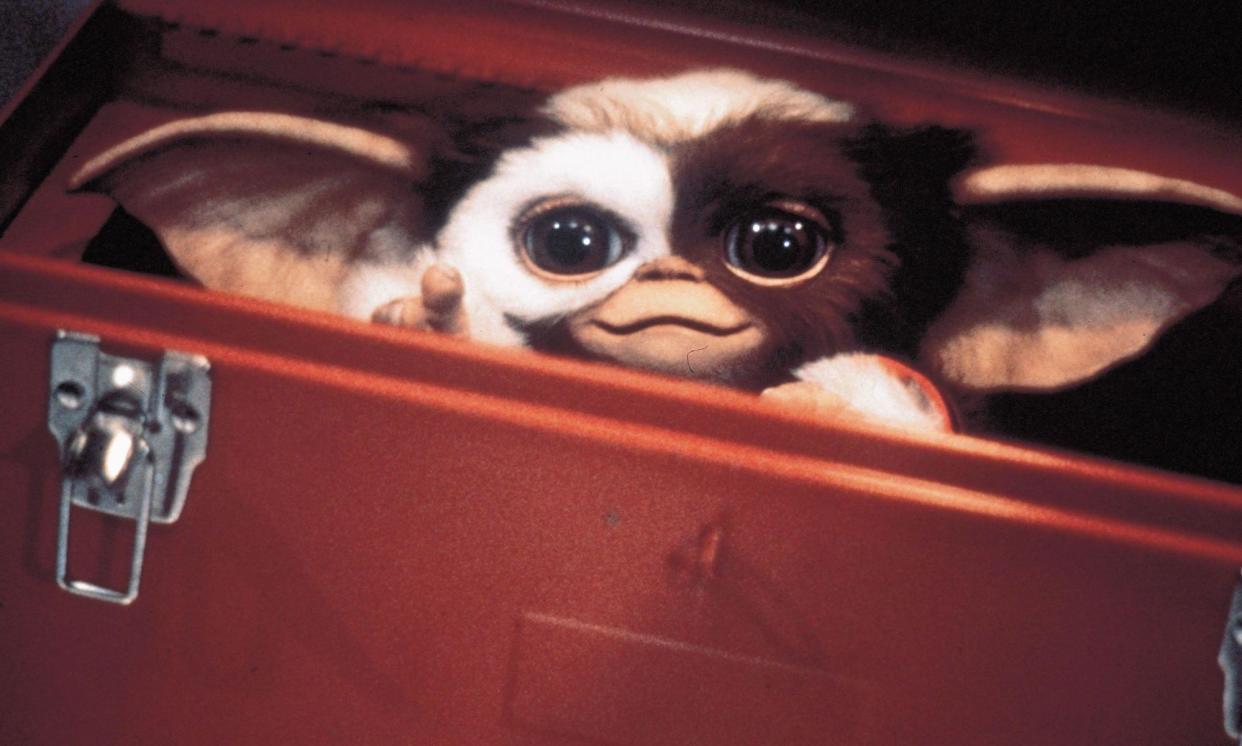Gremlins at 40: Joe Dante’s untamed classic is a love letter to chaos

There’s no character in Joe Dante’s Gremlins more beloved than Randall Peltzer (Hoyt Axton), a struggling inventor from small-town Kingston Falls who travels the country bearing a great sales pitch (“I make the illogical logical”) and a bunch of products that keep backfiring on him. His Bathroom Buddy, a combination shaving mirror/toothbrush/toothpick/nail file/dental mirror, could be a Swiss army knife for overnighters were it not for a misfiring toothpaste button. His coffee machine makes sludge. His peeler-juicer is a kitchen-wide pulp explosion. And his egg-cracker is much more successful at breaking eggs than it’s designed to be.
Related: Once Upon a Time in America at 40: Sergio Leone’s brutal gangster epic endures
Yet when Randall comes home for Christmas, he’s greeted to a hero’s welcome from his son, Billy (Zach Galligan), and his wife, Lynn (Frances Lee McCain), who laments that her husband’s inventions only work well for a couple of weeks, but never seems disappointed by him. He brings a cheerful disorder into their world that a more conventional breadwinner would not, and they love him for it. This year, he’s come home with a one-of-a-kind gift from a tucked-away shop in Chinatown that ends up swallowing the entire town in chaos. Yet when this all-night orgy of mayhem finally stops, he suffers no damage to his reputation. He is, at worst, a lovable screw-up.
That’s the Joe Dante touch, and that’s what made Gremlins such a treat in 1984, when summer blockbusters were edging toward conventionality, and why it remains so now, 40 years later, when Hollywood studios have become even more risk-averse. Though it may not have been completely obvious until Warner Bros gave Dante carte blanche to make his magnificently bugnuts sequel, 1990’s Gremlins 2: The New Batch, Dante’s sympathies lay not with Gizmo, the cuddly little “mogwai” Randall discovers in Chinatown, but with the gnarled beasties who torture Gizmo and turn the all-American town of Kingston Falls upside down. Dante has made down-the-dial counter-programming for It’s a Wonderful Life, fit for jolly anarchists and Looney Tunes junkies.
For the second time in two years as a producer, Steven Spielberg, the ascendent king of mainstream film-making, brought in a horror director to darken the wholesome, family-friendly spaces his work was occupying. First, he hired The Texas Chain Saw Massacre director Tobe Hooper for the suburban shocker Poltergeist, still the ideal PG-rated entryway for kids who are curious about the genre. Then, impressed by Dante’s work on the first-rate Jaws knockoff Piranha and its resourceful follow-up, The Howling, Spielberg executive-produced Gremlins, which thrives on Dante’s combination of unrivaled cinephilia and an excitement over playing in the genre sandbox. And if he freaks a few kids out or alarms their overprotective parents, all the better.
The Peltzers have no business taking care of Gizmo, who must be kept away from bright light and water and must not, under any circumstances, eat after midnight. (The fact that it’s always after midnight is a bit of pedantry that Dante tackles in the sequel.) It takes absolutely no time at all for Billy and the family to violate all those rules, which result in the mogwai first multiplying into mischievous clones and then cocooning like the xenomorphs in Alien, later emerging as scaly, malevolent beasts hellbent on destruction. Credit Dante and his soon-to-be-famous screenwriter, Home Alone’s Chris Columbus, with establishing some key supporting players before things go awry, including Billy’s love interest, Kate (Phoebe Cates), the cantankerous Murray Futterman (Dante mainstay Dick Miller) and Mrs Deagle (Polly Holliday), the town’s miserly widow.
Released just two weeks after Spielberg’s Indiana Jones and the Temple of Doom, Gremlins cracked open a nationwide conversation about violence in family films and led to the creation of PG-13, intended to covering the wide gulf between all-ages fare and films aimed at adults. How that new rating would reshape American movies is a massive and mostly deflating discussion, but Dante’s willingness to spook his younger audience rather than infantilize it is laudable, because it’s done in the right spirit. A sequence like Lynn fighting off a gremlin assault in her kitchen with a knife, various Peltzer appliances and a microwave is shot like a straight-up horror movie, but is hilariously gooey fun, a gateway for kids to experience what it’s like to be shocked into cathartic laughter.
If anything, a gruesome monologue late in the film where Kate talks about why she doesn’t like Christmas is the only lasting violence in Gremlins, because of the likelihood that many children in the audience learned, as she did, that Santa Claus wasn’t real. Other scares are owed mostly to Dante’s skill as a film-maker, like a science teacher who tries to assuage a hiding gremlin with a candy bar and nearly loses an arm, or that awful Mrs Deagle getting catapulted out of her second-story window. Dante had been used to doing a lot with a little – his 1976 debut feature Hollywood Boulevard, co-directed with Allan Arkush, was billed as the cheapest film Roger Corman’s New World Pictures ever made – so given the resources of a Hollywood studio for the first time, he and designer Chris Walas fill the screen with wriggling puppets and marionettes, each managed with care and imagination.
The film leaves the audiences with warnings about the follies of man (“You do with mogwai what your society has done with all of nature’s gifts,” scolds its elderly Chinese keeper) and the “gremlins” that create havoc in our machines and other parts of our life. But Dante doesn’t seem remotely sincere about that latter point, as the sequel and all of his subsequent work would bear out. Our lives are often enriched by the bedlam that upends our plans and shakes up the stultifying order we try to impose on them. And that can happen at the movies.

 Yahoo Movies
Yahoo Movies 
